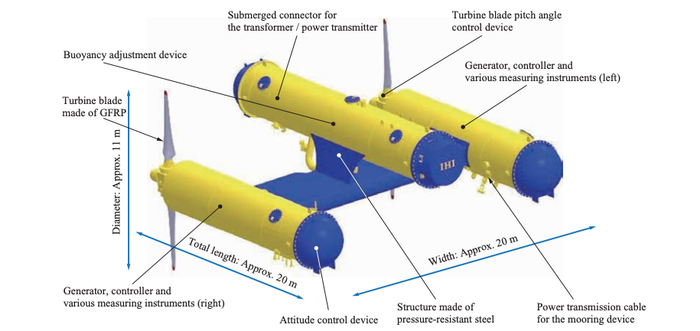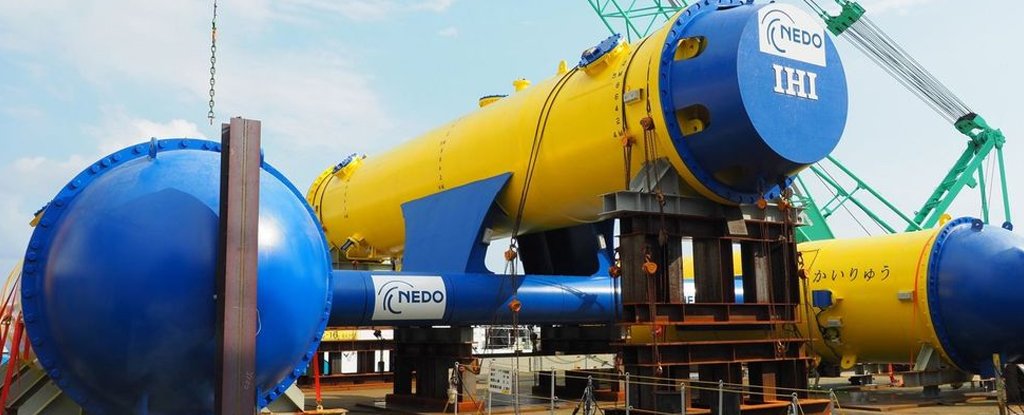Products You May Like
Deep beneath the waves there’s a source of power quite unlike any other. To tap into it, Japanese engineers have constructed a true leviathan, a beast capable of withstanding the strongest of ocean currents to transform its flow into a virtually limitless supply of electricity.
Ishikawajima-Harima Heavy Industries – now known simply as IHI Corporation – has been tinkering with the technology for over a decade now, partnering with New Energy and Industrial Technology Development Organization (NEDO) in 2017 to put their designs to the test.
In February, the project passed a major milestone with the completion of a successful three-and-a-half year field test in the waters off Japan’s southwestern coast.
The 330-ton prototype is called Kairyu, a word that translates more or less into ‘ocean current’. Its structure consists of a 20 meter (66 foot) long fuselage flanked by a pair of similar-sized cylinders, each housing a power generation system attached to an 11 meter long turbine blade.
 (IHI Corp./NEDO)
(IHI Corp./NEDO)
When tethered to the ocean floor by an anchor line and power cables, the device can orient itself to find the most efficient position to generate power from the push of a deep-water current, and channel it into a grid.
Japan is a country heavily reliant on importing fossil fuels to generate a significant amount of its power. With public sentiment towards nuclear power souring in the wake of the 2011 Fukushima nuclear disaster, Japan is motivated to use its technological prowess to take advantage of renewable energy sources.
Unfortunately, the mountainous Japanese archipelago provides little scope for vast forests of wind turbines or fields of solar panels. With a location far from neighboring countries, there’s also less opportunity to balance the fluctuations in renewables through energy trade.
One thing the nation does have is vast stretches of coastal water. To the east, the ocean swirls under the might of the North Pacific gyre.
Where the gyre meets Japan, it’s channeled into a relatively strong flow called the Kuroshio current.
IHI estimates that if the energy present in the current could be harnessed, it could feasibly generate around 205 gigawatts of electricity, an amount it claims is in the same ballpark as the country’s current power generation.
That enormous amount of potential in the ocean’s tumultuous movements is also what makes it so hard to use as a power source. The fastest-flowing waters are near the surface, which also happens to be where typhoons can easily destroy power stations.
Kairyu was designed to hover roughly 50 meters below the waves – as it floats towards the surface, the drag created provides the necessary torque on the turbines. Each of the blades rotates in an opposing direction as well, keeping the device relatively stable.
In a flow of two to four knots (around one to two meters per second), Kairyu was found to be capable of churning out a total of 100 kilowatts of power.
Compared with an average offshore wind turbine’s 3.6 megawatts, it might seem like small sparks. But with demonstrated success at withstanding what nature can throw at it, Kairyu could soon have a monster sibling swinging 20-meter-long turbines to generate a more respectable 2 megawatts.
If all goes to plan, we might see a farm of power generators feeding electricity into the grid some time next decade. Whether Kairyu can indeed scale up is left to be seen.
In spite of huge interest in this relatively under-utilized reserve of renewable energy, attempts to wring watts out of the tides, waves, and currents of the open ocean typically end in failure. High engineering costs, environmental limitations, proximity of coastal areas to the grid … all manner of challenges need to be overcome to see projects like this through.
If IHI Corp. can overcome them, there are kaiju-sized benefits to reap, with ocean power potentially providing anywhere from 40 to 70 percent of Japan’s energy needs.
With advances in materials science and a better understanding of the marine environment, somebody is bound to overcome the litany of problems to harness the ocean’s vast supply of energy.
